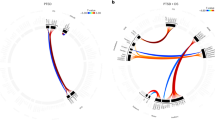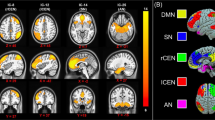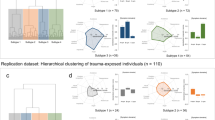Abstract
Trauma-related pathological dissociation is characterized by disruptions in one’s sense of self, perceptual, and affective experience. Dissociation and its trauma-related antecedents disproportionately impact women. However, despite the gender-related prevalence and high individual and societal costs, dissociation remains widely underappreciated in clinical practice. Moreover, dissociation lacks a synthesized neurobiological model across its subtypes. Leveraging the Triple Network Model of psychopathology, we sought to parse heterogeneity in dissociative experience by examining functional connectivity of three core neurocognitive networks as related to: (1) the dimensional dissociation subtypes of depersonalization/derealization and partially-dissociated intrusions; and, (2) the diagnostic category of dissociative identity disorder (DID). Participants were 91 women with and without: a history of childhood trauma, current posttraumatic stress disorder (PTSD), and varied levels of dissociation. Participants provided clinical data about dissociation, PTSD symptoms, childhood maltreatment history, and completed a resting-state functional magnetic resonance imaging scan. We used a novel statistical approach to assess both overlapping and unique contributions of dissociation subtypes. Covarying for age, childhood maltreatment and PTSD severity, we found dissociation was linked to hyperconnectivity within central executive (CEN), default (DN), and salience networks (SN), and decreased connectivity of CEN and SN with other areas. Moreover, we isolated unique connectivity markers associated with depersonalization/derealization in CEN and DN, to partially-dissociated intrusions in CEN, and to DID in CEN. This suggests dissociation subtypes have robust functional connectivity signatures that may serve as targets for PTSD/DID treatment engagement. Our findings underscore dissociation assessment as crucial in clinical care, in particular, to reduce gender-related health disparities.
Similar content being viewed by others
Log in or create a free account to read this content
Gain free access to this article, as well as selected content from this journal and more on nature.com
or
References
American Psychiatric Association. Diagnostic and statistical manual of mental disorders. 5th ed. Washington DC: American Psychiatric Association Publishing; 2022. text rev.
Dalenberg CJ, Brand BL, Gleaves DH, Dorahy MJ, Loewenstein RJ, Cardeña E, et al. Evaluation of the evidence for the trauma and fantasy models of dissociation. Psychol Bull. 2012;138:550–88.
Vissia EM, Giesen ME, Chalavi S, Nijenhuis ERS, Draijer N, Brand BL, et al. Is it Trauma- or Fantasy-based? Comparing dissociative identity disorder, post-traumatic stress disorder, simulators, and controls. Acta Psychiatr Scand. 2016;134:111–28.
Brand BL, Sar V, Stavropoulos P, Krüger C, Korzekwa M, Martínez-Taboas A, et al. Separating Fact from Fiction: An Empirical Examination of Six Myths About Dissociative Identity Disorder. Harv Rev Psychiatry. 2016;24:257–70.
AATS Reinders, Veltman DJ. Dissociative identity disorder: out of the shadows at last? Br J Psychiatry. 2021;219:413–4.
Lebois LAM, Ross DA, Kaufman ML. “I Am Not I”: The Neuroscience of Dissociative Identity Disorder. Biol Psychiatry. 2022;91:e11–e13.
Corrigan F, Hull A. The shadow costs of dissociative identity disorder. Br J Psychiatry. 2022;220:98–98.
Dell PF. 15 The Phenomena of Pathological Dissociation. In: Dell PF, O’Neil JA, editors. Dissociation and the dissociative disorders: DSM-V and beyond. New York: Routledge; 2010, p. 225–37.
Dell PF. A new model of dissociative identity disorder. Psychiatr Clin North Am. 2006;29:1–26.
Putnam FW. The way we are: How states of mind influence our identities, personality and potential for change. New York: International Psychoanalytic Books (IPBooks); 2016.
Ebner-Priemer UW, Mauchnik J, Kleindienst N, Schmahl C, Peper M, Rosenthal MZ, et al. Emotional learning during dissociative states in borderline personality disorder. J Psychiatry Neurosci. 2009;34:214–22.
Lanius RA, Boyd JE, McKinnon MC, Nicholson AA, Frewen P, Vermetten E, et al. A review of the neurobiological basis of trauma-related dissociation and its relation to cannabinoid-and opioid-mediated stress response: a transdiagnostic, translational approach. Curr Psychiatry Rep. 2018;20:118.
Reinders AATS, Willemsen ATM, den Boer JA, Vos HPJ, Veltman DJ, Loewenstein RJ. Opposite brain emotion-regulation patterns in identity states of dissociative identity disorder: a PET study and neurobiological model. Psychiatry Res. 2014;223:236–43.
Roydeva MI, Reinders AATS. Biomarkers of pathological dissociation: a systematic review. Neurosci Biobehav Rev. 2020;123:120–202.
Kessler RC, Sonnega A, Bromet E, Hughes M, Nelson CB. Posttraumatic stress disorder in the National Comorbidity Survey. Arch Gen Psychiatry. 1995;52:1048–60.
Sar V, Akyüz G, Doğan O. Prevalence of dissociative disorders among women in the general population. Psychiatry Res. 2007;149:169–76.
Sar V. Epidemiology of dissociative disorders: An overview. Epidemiol Res Int. 2011;2011:1–8.
Menon V. Large-scale brain networks and psychopathology: a unifying triple network model. Trends Cogn Sci. 2011;15:483–506.
Smith SM, Fox PT, Miller KL, Glahn DC, Fox PM, Mackay CE, et al. Correspondence of the brain’s functional architecture during activation and rest. Proc Natl Acad Sci USA. 2009;106:13040–5.
Laird AR, Fox PM, Eickhoff SB, Turner JA, Ray KL, McKay DR, et al. Behavioral interpretations of intrinsic connectivity networks. J Cogn Neurosci. 2011;23:4022–37.
Uddin LQ, Yeo BTT, Spreng RN. Towards a Universal Taxonomy of Macro-scale Functional Human Brain Networks. Brain Topogr. 2019;32:926–42.
Andrews-Hanna JR, Reidler JS, Sepulcre J, Poulin R, Buckner RL. Functional-anatomic fractionation of the brain’s default network. Neuron 2010;65:550–62.
Andrews-Hanna JR, Smallwood J, Spreng RN. The default network and self-generated thought: component processes, dynamic control, and clinical relevance. Ann N. Y Acad Sci. 2014;1316:29–52.
Ward AM, Schultz AP, Huijbers W, Van Dijk KRA, Hedden T, Sperling RA. The parahippocampal gyrus links the default-mode cortical network with the medial temporal lobe memory system. Hum Brain Mapp. 2014;35:1061–73.
Buckner RL, Andrews-Hanna JR, Schacter DL. The Brain’s Default Network: Anatomy, Function, and Relevance to Disease. Ann N. Y Acad Sci. 2008;1124:1–38.
Menon V, Uddin LQ. Saliency, switching, attention and control: a network model of insula function. Brain Struct Funct. 2010;214:655–67.
Nickerson LD. Replication of Resting State-Task Network Correspondence and Novel Findings on Brain Network Activation During Task fMRI in the Human Connectome Project Study. Sci Rep. 2018;8:17543.
Lotfinia S, Soorgi Z, Mertens Y, Daniels J. Structural and functional brain alterations in psychiatric patients with dissociative experiences: a systematic review of magnetic resonance imaging studies. J Psychiatr Res. 2020;128:5–15.
Nicholson AA, Harricharan S, Densmore M, Neufeld RWJ, Ros T, McKinnon MC, et al. Classifying heterogeneous presentations of PTSD via the default mode, central executive, and salience networks with machine learning. Neuroimage Clin. 2020;27:102262.
Lebois LAM, Harnett NG, Van Rooij SJH, Ely TD, Jovanovic T, Bruce SE, et al. Persistent Dissociation and Its Neural Correlates in Predicting Outcomes After Trauma Exposure. Am J Psychiatry. https://doi.org/10.1176/appi.ajp.21090911.
Lebois LAM, Li M, Baker JT, Wolff JD, Wang D, Lambros AM, et al. Large-Scale Functional Brain Network Architecture Changes Associated With Trauma-Related Dissociation. Am J Psychiatry. 2021;178:165–73.
Schlumpf YR, Nijenhuis ERS, Chalavi S, Weder EV, Zimmermann E, Luechinger R, et al. Dissociative part-dependent biopsychosocial reactions to backward masked angry and neutral faces: An fMRI study of dissociative identity disorder. Neuroimage Clin. 2013;3:54–64.
Schlumpf YR, AATS Reinders, Nijenhuis ERS, et al. part-dependent resting-state activity in dissociative identity disorder: a controlled FMRI perfusion study. PLoS ONE. 2014;9:e98795.
Sar V, Unal SN, Kiziltan E, Kundakci T, Ozturk E. HMPAO SPECT Study of Regional Cerebral Blood Flow in Dissociative Identity Disorder. J Trauma Dissociation. 2001;2:5–25.
Sar V, Unal SN, Ozturk E. Frontal and occipital perfusion changes in dissociative identity disorder. Psychiatry Res. 2007;156:217–23.
Reinders AATS, Willemsen ATM, Vissia EM, Vos HPJ, den Boer JA, Nijenhuis ERS. The Psychobiology of Authentic and Simulated Dissociative Personality States: The Full Monty. J Nerv Ment Dis. 2016;204:445–57.
Reinders AATS, Nijenhuis ERS, Paans AMJ, Korf J, Willemsen ATM, den Boer JA. One brain, two selves. Neuroimage 2003;20:2119–25.
Pruim RHR, Beckmann CF, Oldehinkel M, Oosterlaan J, Heslenfeld D, Hartman CA, et al. An Integrated Analysis of Neural Network Correlates of Categorical and Dimensional Models of Attention-Deficit/Hyperactivity Disorder. Biol Psychiatry Cogn Neurosci Neuroimaging. 2019;4:472–83.
von Elm E, Altman DG, Egger M, Pocock SJ, Gøtzsche PC, Vandenbroucke JP, et al. The Strengthening the Reporting of Observational Studies in Epidemiology (STROBE) statement: guidelines for reporting observational studies. Lancet 2007;370:1453–7.
First MB, Gibbon M. The Structured Clinical Interview for DSM-IV Axis I Disorders (SCID-I) and the Structured Clinical Interview for DSM-IV Axis II Disorders (SCID-II). In Hilsenroth MJ, Segal DL, editors. Comprehensive handbook of psychological assessment, Vol. 2. Personality assessment. New Jersey: John Wiley & Sons, Inc.; 2004, p. 134–3.
Weathers FW, Bovin MJ, Lee DJ, Sloan DM, Schnurr PP, Kaloupek DG, et al. The Clinician-Administered PTSD Scale for DSM–5 (CAPS-5): Development and initial psychometric evaluation in military veterans. Psychological Assessment. 2018;30:383–95.
Steinberg M, Cicchetti D, Buchanan J, Hall P, et al. Clinical assessment of dissociative symptoms and disorders: The Structured Clinical Interview for DSM-IV Dissociative Disorders (SCID-D). Dissociation: Progress in the Dissociative Disorders. 1993;6:3–15.
Dell PF. The multidimensional inventory of dissociation (MID): A comprehensive measure of pathological dissociation. J Trauma Dissociation. 2006;7:77–106.
Bernstein DP, Fink L, Handelsman L, Foote J. Childhood Trauma Questionnaire. The American Journal of PsychiatryAssessment of Family Violence: a Handbook for Researchers and Practitioners. https://doi.org/10.1037/t02080-000.
Esteban O, Markiewicz CJ, Blair RW, Moodie CA, Isik AI, Erramuzpe A, et al. fMRIPrep: a robust preprocessing pipeline for functional MRI. Nat. methods. 2019;16:111–6.
Beckmann CF, Smith SM. Probabilistic Independent Component Analysis for Functional Magnetic Resonance Imaging. IEEE Trans Med Imaging. 2004;23:137–52.
Nickerson LD, Smith SM, Öngür D, Beckmann CF. Using Dual Regression to Investigate Network Shape and Amplitude in Functional Connectivity Analyses. Front Neurosci. 2017;11:115.
Beckmann CF, DeLuca M, Devlin JT, Smith SM. Investigations into resting-state connectivity using independent component analysis. Philos Trans R Soc Lond B Biol Sci. 2005;360:1001–13.
Fani N, King TZ, Powers A, Hardy RA, Siegle GJ, Blair RJ, et al. Cognitive and neural facets of dissociation in a traumatized population. Emotion. 2018. https://doi.org/10.1037/emo0000466.
McKinnon MC, Boyd JE, Frewen PA, Lanius UF, Jetly R, Richardson JD, et al. A review of the relation between dissociation, memory, executive functioning and social cognition in military members and civilians with neuropsychiatric conditions. Neuropsychologia 2016;90:210–34.
Blanke O, Mohr C, Michel CM, Pascual-Leone A, Brugger P, Seeck M, et al. Linking out-of-body experience and self processing to mental own-body imagery at the temporoparietal junction. J Neurosci. 2005;25:550–7.
Ranganath C, Ritchey M. Two cortical systems for memory-guided behaviour. Nat Rev Neurosci. 2012;13:713–26.
Leech R, Sharp DJ. The role of the posterior cingulate cortex in cognition and disease. Brain 2014;137:12–32.
Vissia EM, Lawrence AJ, Chalavi S, Giesen ME, Draijer N, Nijenhuis ERS, et al. Dissociative identity state-dependent working memory in dissociative identity disorder: a controlled functional magnetic resonance imaging study. BJPsych Open. 2022;8:e82.
Elzinga BM, Ardon AM, Heijnis MK, De Ruiter MB, Van Dyck R, Veltman DJ. Neural correlates of enhanced working-memory performance in dissociative disorder: a functional MRI study. Psychol Med. 2007;37:235–45.
Weniger G, Siemerkus J, Barke A, Lange C, Ruhleder M, Sachsse U, et al. Egocentric virtual maze learning in adult survivors of childhood abuse with dissociative disorders: evidence from functional magnetic resonance imaging. Psychiatry Res. 2013;212:116–24.
Acknowledgements
The authors would like to thank the study participants and the hospital staff for their time, assistance, and support.
Funding
This research was supported by the Julia Kasparian Fund for Neuroscience Research (LAML, CAP, MLK) and the National Institute of Mental Health K01 MH118467 (LAML), R21 MH112956 (MLK), and R01 MH119227 (MLK).
Author information
Authors and Affiliations
Contributions
LAML: Conceptualization, Methodology, Investigation, Resources, Data Curation, Writing—Original Draft, Visualization, Supervision, Project administration, Funding acquisition; PK: Conceptualization, Methodology, Software, Formal analysis, Data Curation, Writing—Original Draft; CAP: Investigation, Data Curation, Writing—Review & Editing, Project administration; AML: Investigation, Writing—Review & Editing; LO: Investigation, Writing—Review & Editing; JDW: Investigation, Writing—Review & Editing, Project administration; JTB: Conceptualization, Writing—Review & Editing; SAG: Conceptualization, Supervision, Writing—Review & Editing; NLS: Investigation, Writing—Review & Editing; KJR: Conceptualization, Writing—Review & Editing; MAR: Writing—Review & Editing; SW: Conceptualization, Investigation, Writing—Review & Editing; LDN: Conceptualization, Methodology, Software, Formal analysis, Writing—Review & Editing, Supervision; MLK: Conceptualization, Investigation, Resources, Writing—Review & Editing, Supervision, Project administration, Funding acquisition.
Corresponding author
Ethics declarations
Competing interests
LAML reports unpaid membership on the Scientific Committee for the International Society for the Study of Trauma and Dissociation (ISSTD), grant support from the National Institute of Mental Health (NIMH), K01 MH118467, and the Julia Kasparian Fund for Neuroscience Research. Dr LAML also reports spousal IP payments from Vanderbilt University for technology licensed to Acadia Pharmaceuticals unrelated to the present work. KJR has performed scientific consultation for Bioxcel, Bionomics, Acer, Takeda, and Jazz Pharma; serves on Scientific Advisory Boards for Sage and the Brain Research Foundation, and he has received sponsored research support from Takeda, Brainsway and Alto Neuroscience. He receives research funding from the NIH. MLK reports unpaid membership on the Scientific Committee for the ISSTD and grant support from the NIMH, R21 MH112956, R01 MH119227. JTB has received consulting fees from Verily Life Sciences, as well as consulting fees and equity from Mindstrong Health, Inc., unrelated the present work. Neither ISSTD nor any funding sources were involved in the analysis or preparation of the paper. All other authors have nothing to report.
Additional information
Publisher’s note Springer Nature remains neutral with regard to jurisdictional claims in published maps and institutional affiliations.
Supplementary information
Rights and permissions
Springer Nature or its licensor holds exclusive rights to this article under a publishing agreement with the author(s) or other rightsholder(s); author self-archiving of the accepted manuscript version of this article is solely governed by the terms of such publishing agreement and applicable law.
About this article
Cite this article
Lebois, L.A.M., Kumar, P., Palermo, C.A. et al. Deconstructing dissociation: a triple network model of trauma-related dissociation and its subtypes. Neuropsychopharmacol. 47, 2261–2270 (2022). https://doi.org/10.1038/s41386-022-01468-1
Received:
Revised:
Accepted:
Published:
Issue date:
DOI: https://doi.org/10.1038/s41386-022-01468-1
This article is cited by
-
Dissociative experiences alter resting state functional connectivity after childhood abuse
Scientific Reports (2025)
-
How insights from posttraumatic stress disorder can inform treatment of functional neurological disorder
Nature Reviews Psychology (2025)
-
A Fragmented Mind: Altered States of Consciousness and Spirit Possession Between Rituals and Therapy
Integrative Psychological and Behavioral Science (2025)
-
Proposition of Two Subtypes of Patients at Risk of Suicide: Pain Hypersensitive Vs. Dissociative
Current Psychiatry Reports (2025)
-
The nested hierarchical model of self and its non-relational vs relational posttraumatic manifestation: an fMRI meta-analysis of emotional processing
Molecular Psychiatry (2024)



